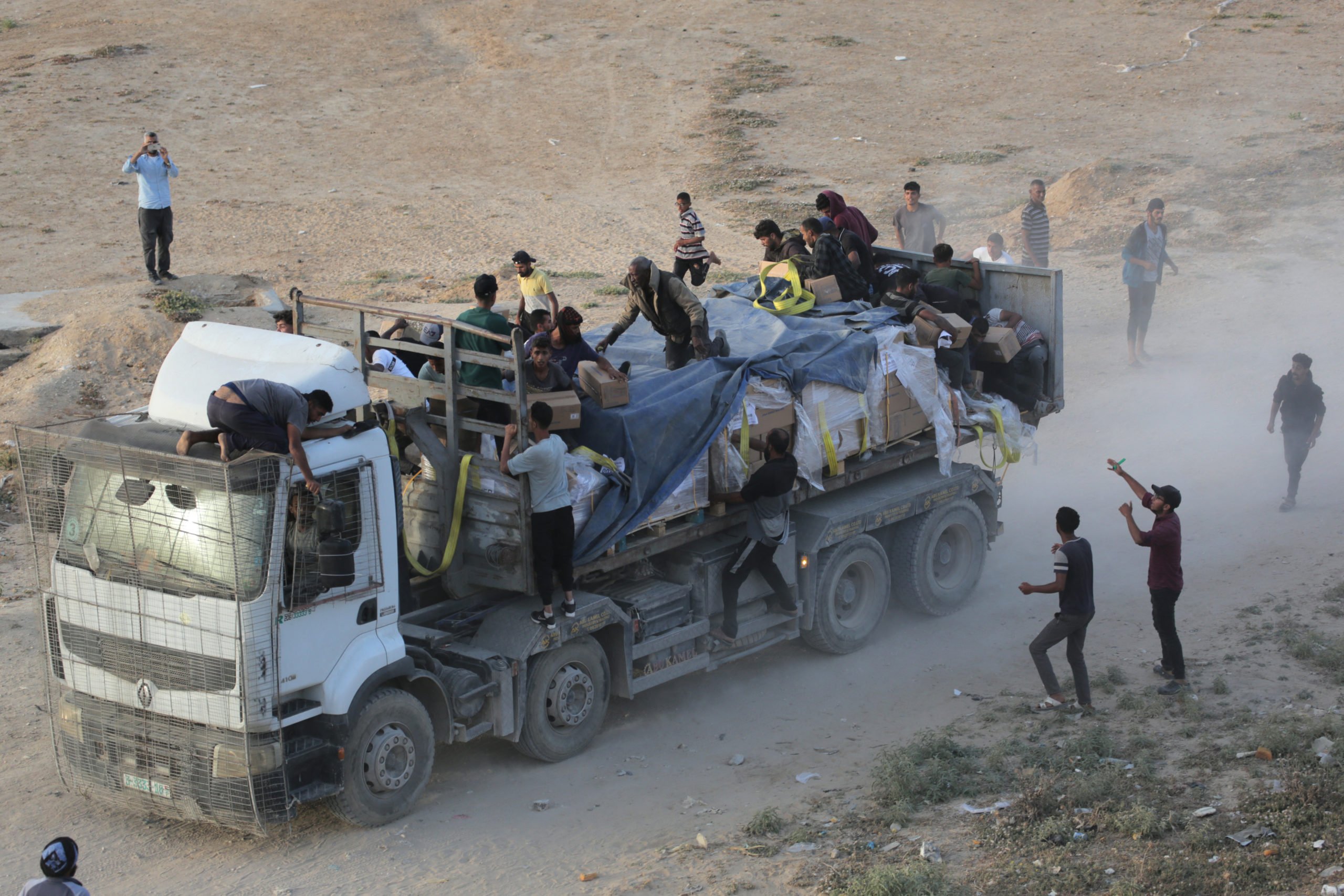New problems are mounting for the Biden administration’s $320 million floating Gaza aid pier, which was already facing setbacks despite becoming operational less than two weeks ago.
The U.S. military was forced to halt aid shipments to Gaza on Tuesday after the floating pier was battered by bad weather over the weekend. The damage sustained from the weather is only the latest in a string of logistical and operational problems that have plagued the pier since it was constructed in mid-May. (RELATED: ‘Floating Abbey Gate’: Even Biden’s Biggest Cheerleaders Sound Alarm On Gaza Pier Scheme)
The JLOTS pier was a “horrible idea,” Michael DiMino, senior fellow at Defense Priorities and former CIA official, told the Daily Caller News Foundation. “It’s a horrible idea due to the challenges that we just saw basically wreck the whole project.”
“It was never a sound plan to begin with… whether it’s accidents, or logistical hurdles, or risk to our troops and all these problems that have come to fruition. I don’t think that there should be any effort to try to continue this, or salvage it, or fix it,” DiMino said, pointing to safer, more effective methods of delivering aid to Gaza. “I think now is an opportunity to say this failed. Let’s wrap this up before we continue to tempt fate.”
Biden’s floating pier in Gaza appears to be sinking pic.twitter.com/bN8WxSZLXh
— Daily Caller (@DailyCaller) May 28, 2024
Getting aid into Gaza via the JLOTS system requires several steps. Aid is first delivered by vessels to the floating pier located roughly two miles off the Gaza coastline, where it is facilitated and examined by U.S. officials. It is then picked up by loading vessels and transferred back to a separate causeway pier attached to the shores of Gaza and trucked by various aid groups to warehouses for distribution.
Pentagon spokeswoman Sabrina Singh confirmed that U.S. aid deliveries had been halted after rough weather and choppy waters broke the causeway pier apart on Tuesday, rendering it useless for the time being. The pier will be removed from the coast of Gaza and towed northbound to Israel for repairs; it will take “at least over a week” to fix the pier before it can be re-anchored, Singh told reporters.
“We had a perfect storm of high sea states… creating not an optimal environment to operate this JLOTS pier,” Singh said Tuesday, responding to a question as to whether the pier is too fragile to withstand tough conditions. “Hopefully weather conditions won’t hinder it anymore [once it is operational again].”

WASHINGTON, DC – MAY 28: White House National Security Communications Advisor John Kirby (R) shows his frustration with a question about military definitions as he and White House Press Secretary Karine Jean-Pierre speak to reporters during the daily news conference in the Brady Press Briefing Room at the White House (Photo by Chip Somodevilla/Getty Images)
The pier can only be operated during favorable sea conditions, in a maximum of three-foot waves and wind speeds not exceeding than 15 miles per hour. Aside from the minimum week timeline, reconstruction efforts cannot take place if conditions are poor, possibly adding further delays. (RELATED: Biden Admin Urges Allies Against Confronting Iran On Nuclear Program Ahead Of US Elections: REPORT)
The incident comes just a day after a separate stint of bad weather unmoored four U.S. Army vessels supporting the JLOTS system and sent them floating away from the operational site off the coast of Gaza. Two vessels floated north and were beached in Ashdod, Israel, while the other two anchored on the Gaza coast near the causeway. One of the vessels has been recovered, and the other three will be recovered by Thursday, Singh told reporters during Tuesday’s press briefing.
A video from the incident appears to depict U.S. troops from one of the beached vessels in Gaza stranded on the shores while awaiting rescue, despite the Biden administration’s promise that there would be no U.S. “boots on the ground” in the region during JLOTS operations.

American soldiers stand next to one of two US Army vessels that ran aground in Israel’s coastal city of Ashdod on May 25, 2024. The US military said four of its vessels, supporting a temporary pier built to deliver aid to Gaza by sea, had run aground in heavy seas.(Photo by OREN ZIV/AFP via Getty Images)
“This is amateur hour. It’s unacceptable that there’s so little planning that appears to have gone into this, to the point where half a dozen U.S. troops are washed ashore in a war zone surrounded by Hamas,” DiMino told the DCNF.
That problem was preceded by another incident last week in which three U.S. troops suffered injuries during JLOTS operations. While exact details haven’t been disclosed — other than that it was a non-combat incident — two of the troops suffered minor injuries and the third was critically injured and subsequently evacuated to an Israeli hospital for emergency care. The troop is still in critical condition, Singh said Tuesday.
Days after the JLOTS system was constructed, shipments that made it to the shores of Gaza via the causeway and floating pier were quickly stolen from trucks by crowds of hungry civilians, creating security concerns among aid groups responsible for distribution. There are also security concerns for the U.S. troops supporting the JLOTS operations; Pentagon officials, including Department of Defense Secretary Lloyd Austin, have admitted there is a baseline risk that Hamas operatives on the ground in Gaza could stage an attack on the causeway or fire at troops offshore. (RELATED: Biden Admin Expresses ‘Official Condolences’ For Death Of Iranian President Who Was Dubbed The ‘Butcher Of Tehran’)

TOPSHOT – Palestinians rush trucks as they transport international humanitarian aid from the US-built Trident Pier near Nuseirat in the central Gaza Strip on May 18, 2024, amid the ongoing conflict between Israel and the militant group Hamas. (Photo AFP via Getty Images)
More broadly, only a fraction of the aid needed to address the humanitarian needs of the millions of Palestinians in Gaza can be delivered via the JLOTS system, even when fully operational. U.S. officials have said that roughly 90 trucks worth of aid will be delivered to Gaza via JLOTS in the interim, eventually up to 150 trucks once the system is at full capacity.
But a UN official previously told the DCNF in a statement that hundreds of trucks of aid are needed on a daily basis.
“That makes the pier a relative drop in the bucket at best — a waste of $320 million American taxpayer dollars and the futile deployment of 1,000 U.S. service personnel,” Shoshana Bryen, senior policy director at the Jewish Policy Center, previously told the DCNF.
It is far safer and more effective to deliver aid to the Palestinians through other methods, chiefly by truck convoys through border crossings in Egypt to the south and Israel to the east. The international community has expressed concern that Israel and Egypt are not allowing enough aid to enter through these crossings, though Israel counters that it is already going to great lengths to ensure delivery; Egypt refused to allow hundreds of trucks worth of aid to enter Gaza through the Rafah border crossing until recently.
All content created by the Daily Caller News Foundation, an independent and nonpartisan newswire service, is available without charge to any legitimate news publisher that can provide a large audience. All republished articles must include our logo, our reporter’s byline and their DCNF affiliation. For any questions about our guidelines or partnering with us, please contact licensing@dailycallernewsfoundation.org.



